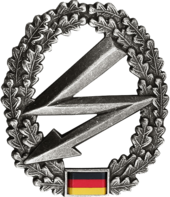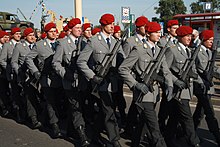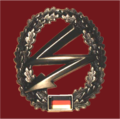Telecommunication troops (Bundeswehr)
The Signal Corps is a branch of service in the army and in the Joint Support of the Armed Forces . In the army, the telecommunications force is one of the operational and command support troops / command base area 6 . The telecommunications troops in the army are responsible for the operation of the army's communications and information network.
assignment
The telecommunication troops set up telecommunication connections and operate them. The fast and secure transmission of messages, information and orders is one of the most important elements of direct communication between command and combat troops. The telecommunications force is responsible for the operation of the army's communications and information network. The telecommunications force is therefore responsible for essential parts of the command post infrastructure .
The telecommunications force is made up of the telecommunications liaison force and the down-to-earth telecommunications services. The telecommunications connection troops establish the connection between troops and command via wire, radio , radio link and satellite communication (SatCom) and transmit messages. This includes all voice , telephone , telex , directional radio, data transmission , image transmission and fax connections . The down-to-earth telecommunications services set up and operate fixed telecommunications systems in peace and connect them to telecommunications networks ( permanent network). In the event of an emergency, this force installs additional special networks on the existing basis .
The electronic warfare is expressly not the task of the telecommunications troops, but the telecommunications troops EloKa . The telecommunication troops use passive electronic protective measures such as concealment , disinformation (to uselessly tie up opposing uncovering capacities) and cryptography to ensure the security of the information transmitted. Further measures are intended to make clearing up the individual communication points (and the command posts connected to them ) and the communication network more difficult.
history
In 1956, five telecommunications battalions for the first five divisions of the army and initially two telecommunications companies for two brigades were set up as the first telecommunications troops . The remaining troops, u. a. Telecommunications battalions for the corps and the telecommunications school of the army were soon planned.
The telecommunications forces were further expanded until 1970, i.e. essentially in Army Structure 2. Telecommunications headquarters were set up in the corps and further telecommunications battalions were set up. The establishment of the extensive telecommunications organization began in the territorial army. The first units of the now independent EloKa were planned within the telecommunications force. In Army Structure 3 (1970 to 1979) a. a. the command telecommunications brigade 900 with two regiments and five telecommunications battalions for the highest command of the Bundeswehr at the BMVg . The automated corps master network (AUTOKO) as well as modern radio and radio relay technology were introduced during this time. In the last structure of the Cold War , additional telecommunications areas were set up in the military areas. A new generation of radios and the second development stage of the AUTOKO (AUTOKO II) were introduced. At the end of 1989 the telecommunications force consisted of 34 battalions .
After reunification , the Bundeswehr was downsized. Around 1995 the telecommunications force consisted of only 22 regiments and battalions, and in 1997 it was reclassified again from 4 command support brigades, a telecommunications reconnaissance brigade, seven command support regiments and numerous other units and facilities. In 2000, the development of the armed forces base began , into which numerous telecommunications forces were integrated. For this purpose, the command support brigades were disbanded and reclassified into regiments and battalions. In the army, some units of the telecommunications force remained as staff and telecommunications companies for direct command support of the staffs of some large units. In 2005 the Army Telecommunications School was also closed. Since then, training has been carried out by the Bundeswehr Command Support School, which is part of the armed forces base.
education
The central training facility for the Army and Armed Forces Base (SKB) is the Bundeswehr Command Support School and the Bundeswehr Technical College for Information Technology (FüUstgSBW / FSBwIT). The telecommunications school and technical college of the army for electrical engineering formerly entrusted with training in the army was dissolved in 2006.
The general of the telecommunications troops is responsible for the telecommunications troops in the army. At the moment this position is connected with the sub-department head IV 1 command support in the command army . The position of general of the telecommunications force is held by an officer with the rank of colonel .
organization
classification
The signal corps is a branch of service in the army and the command support portion of the forces basis of the armed forces . In the army, the German telecommunications troops are among the command support troops . In the armed forces base, the units of the telecommunications force were transferred to the command support units, which consist of army and air force units (see command support in the Bundeswehr ).
The EloKa telecommunications troops were once part of the telecommunications troops, but are now managed as a separate service category due to their different range of tasks.
The army reconnaissance troops , the field intelligence troops and the operational information troops also have special telecommunications capabilities . However, their telecommunications capabilities only serve these branches of service to fulfill their independent primary tasks.
Each unit in the army and the armed forces base has its own sub-unit as a troop transmitter and for command support. Every 1st / staff and supply company of all battalions and regiments is subordinate to a telecommunications platoon and a platoon of staff. However, these forces do not belong to the telecommunications force, but are part of their military category. In the staffs of associations, the S6 officer, as a troop telecommunications officer, processes the planning and processing of telecommunications within the association according to the Special Instructions for Telecommunications (BesAnFm) by the superordinate large association, which has subordinate telecommunications forces of the telecommunications force. The BesAnFm regulates, among other things, the allocation of radio frequencies.
In the Navy and the Air Force , the concept of the branches of service is not known. A telecommunications force in the narrower sense does not exist there. However, the Navy and Air Force also have their own telecommunication forces. At the Air Force, there are particularly specialized telecommunications personnel in the "Command Service" department. In the navy, forces comparable to the telecommunications force can be found primarily in the application series “21 telecommunications operation” and “48 IT system support”.
Legend
The legend applies to all of the following lists
| Legend |
|---|
| Dissolved association |
| Partially active or inactive association |
| Active association |
Troops in the army
The telecommunications force in the army comprises the following troops:
| designation | place | Association | Force category | Deployment concept 2011 | |
|---|---|---|---|---|---|
| Telecommunications Regiment 1 | Rotenburg (Wümme) | 1st Armored Division | - | Disbanded June 30, 2015 | |
| Telecommunications Battalion 4 | Cham (Upper Palatinate) | Armored Brigade 12 | - | Disbanded December 31, 2014 | |
| Mountain Telecommunications Battalion 210 | Bad Reichenhall | Mountain Infantry Brigade 23 | - | Disbanded June 30, 2014 | |
| Telecommunications Battalion 610 | Prenzlau | Multinational Corps North-East ( 1st Panzer Division on duty ) | - | remains | |
| Telecommunications Battalion 701 | Frankenberg / Sa. | Panzer Grenadier Brigade 37 | - | Decommissioned May 2014 | |
| Telecommunications Battalion 801 | Neubrandenburg | Panzer Grenadier Brigade 41 | - | Appeal for dissolution September 5, 2015 | |
| Airborne Telecommunication Battalion Rapid Forces Division "Hessian Lion" |
Stadtallendorf | Fast forces division | - | Decommissioned April 2014 | |
| Telecommunications Battalion Division Air Mobile Operations |
Veitshochheim | Airmobile Operations Division | - | Appeal for dissolution on September 26, 2013 | |
| German share of CIS 2 battalion 1 | Eibergen ( NL ) | 1st German-Dutch Corps | - | remains | |
| Telecommunication company Eurocorps | Lebach | Eurocorps Staff and Support Battalion | - | was relocated to Lebach in 2015 | |
| Telecommunication company special forces command | Calw | Special Forces Command | - | remains |
1 German part of the Dutch-German CIS battalion is a telecommunication company
2 CIS: Communications and Information Systems (→ Communication and Information Systems)
Troops in the cyber and information space
The telecommunication forces integrated in the cyber and information space are, according to their name, immediately scheduled to provide management support. The six associations are subordinate to the Bundeswehr Information Technology Command (KdoITBw).
equipment
Means of communication
- Satcom Mk (ground station using Multiband, BSmM), three-part 4.6 m offset double reflector antenna on trailer frame, broadband RF components with redundancies, transmission capacity up to 3 × 2 Mbit / s encrypted duplex
- AMA 34 m: mobile antenna mast system that can be hydraulically extended up to 34 m. In configuration 1 there are four mirrors with a diameter of 90 cm, which are arranged on one plane. The signals are carried in waveguides from the radio (transmitter / receiver) to the horn. In configuration 2 it is a mirror of 90 cm and a large mirror of 1.75 m.
- Radio relay device CTM 250 ( Siemens ), remotely controllable main unit with the frequency range 4400-5000 MHz in 125 kHz steps, guaranteed capacity of at least 1.54 watts and a maximum of 2 × 8,448 kbit / s. Different basebands enable the bandwidth of 1 × 2/2 × 2 or 1 × 8/2 × 8 Mbit, interface G.703
- Directional radio CTM 350 (Siemens), remotely controllable main unit with a frequency range of 4,400–5,000 MHz in 125 kHz steps, guaranteed output of at least 2 watts and a maximum of 34,368 kbit / s with bandwidth up to 32 Mbit, interface G.703.
- MTT4600: mobile satellite communication antenna
- SEM 80/90 VHF radio ( Thales )
- SEM 93 VHF radio ( Thales ) and new series with integrated digital encryption
- HRM-7000 , small portable HF radio device (EADS TELEFUNKEN RACOMS), frequency range 2.0–29.999 MHz in 100 Hz steps, transmission power 3/30 watts switchable also in versions with 100 watts and 400 watts of power for mobile and stationary systems
- M3TR VHF / UHF radio ( Rohde & Schwarz )
- Containers, called cabins, that can be loaded onto trucks, with electronics for controlling the systems, encrypting the data and as input / output for subscribers (cable input for a normal telephone).
- FF OB / ZB (field telephone for local battery or central battery operation)
uniform
The weapon color of the telecommunications troops, shown for example as the color of the braids and collar tabs , is lemon yellow . The color of the beret is coral red . The beret badge shows a lightning bolt framed by an oak wreath similar to the tactical symbol. In the beret badge, the lightning bolt runs from top right to bottom left and thus resembles the stylized lightning bolt in the tactical symbol of the EloKa telecommunications troop , which tellingly does not differ from those of the telecommunications troops in terms of beret and wire color.
Tactical sign
The basic tactical sign of the telecommunications troops shows the usual NATO conventions a stylized lightning bolt from top left to bottom right. The EloKa telecommunications team has a similar sign: here, the lightning bolt points from top right to bottom left.
Military symbol (basic symbol ) of the NATO telecommunications force
Rank designations
The lowest ranks in units of the telecommunications force are radio operators or tank radio operators . They correspond to the ranks of riflemen , hunters , armored infantry , etc. ( → see here ) of other branches of service.
Soldiers in the lowest rank in units of the telecommunications force, as well as soldiers in the lowest rank in units of the EloKa telecommunications unit , as well as soldiers in the lowest rank in units of the troops for operational communication who do not operate in a fixed task force with armored forces are called radio operators . Examples are the army uniform bearers in the lowest rank in the predominantly fixed telecommunications engineering offices such as command support battalions or telecommunications sections. All other soldiers in the lowest rank of the troop classes listed have the rank of tank operator . These include army uniforms in the lowest rank in the units that are integrated into the armored troops as telecommunication units and as telecommunication platoons, as well as in larger units that are integrated into tank or armored infantry brigades as independent units . The other ranks correspond to the general ranks of the Bundeswehr .
|
|
||
| Lower rank | Higher rank | |
| - |
Radio operator tank operator |
Private |
|
Rank group : Teams-NCOs-NCO-NCOs-Lieutenant-Captains-Staff officers-Generals |
||
Trivia
"The news troop has a hard time, it doesn't stink and it doesn't bang that it exists at all, most people only notice when it no longer works."
literature
- Fernmeldering e. V. (Hrsg.): 50 years of telecommunication troops of the army of the Bundeswehr, data - facts - reports . Koblenz 2006, ISBN 3-00-019622-6 .
- Fernmeldering e. V. (Ed.): The telecommunication troop telecommunication connection service 1976-2004 . 2 vol. ISBN 978-3-00-020652-8 .
- Fernmeldering e. V. (Ed.): Telegraph, intelligence, telecommunications troops and command services - command support since 1899 . Koblenz 1999.
- Emil Hoffmann: The army's telecommunications unit in the Bundeswehr . Mittler, 1978, ISBN 3-8132-0012-4 .
Web links
- The telecommunications force. Federal Ministry of Defense , head of the press and information staff, accessed on December 9, 2010 .
- Command support - information technology in the Bundeswehr. Federal Ministry of Defense , the head of the press and information staff, press and information center for the armed forces base, accessed on December 9, 2010 .
- Hans Georg Kampe: Telecommunication troops of the Bundeswehr. Formation and development of the telecommunications troops of the Bundeswehr. Retrieved December 9, 2010 .
- Website. Fernmeldering eV, accessed on December 9, 2010 .
- Website. Command Support Battalion 281, accessed July 22, 2014 .
- Website. Command Support Battalion 293, accessed July 29, 2014 .
Individual evidence
- ↑ What is the telecommunications force's mission? Federal Ministry of Defense , head of the press and information staff, accessed on December 9, 2010 .
- ↑ Formations of the Army. (No longer available online.) The Federal Archives, archived from the original on April 2, 2015 ; Retrieved December 9, 2010 . Info: The archive link was inserted automatically and has not yet been checked. Please check the original and archive link according to the instructions and then remove this notice.
- ↑ The History of the Telecommunications Corps. Federal Ministry of Defense , head of the press and information staff, accessed on December 9, 2010 .
- ↑ Which units are part of the telecommunications force? Federal Ministry of Defense , the head of the press and information staff, accessed on August 1, 2015 .
- ↑ Telecommunications battalion rolls up the troop flag. Federal Ministry of Defense , head of the press and information staff, accessed on October 21, 2015 .
- ^ Sabine Berthold: Farewell after 40 years. Main Post, September 27, 2013, accessed September 30, 2013 .
- ↑ What equipment and technology do the telecommunications forces use? Federal Ministry of Defense , head of the press and information staff, accessed on December 9, 2010 .
- ↑ a b The equivalent, higher and lower ranks are given in accordance with ZDv 14/5 B 185, cf. The Federal Minister of Defense (ed.): ZDv 14/5. Soldiers Act . DSK AV110100174, change status July 17, 2008. Bonn August 21, 1978, rank designations in the Bundeswehr, p. B 185 (Not to be confused with the Law on the Legal Status of Soldiers (Soldiers Act) . The order of the ranks shown in the info box does not necessarily correspond to one of the regular rank sequences provided for in the Soldiers' Career Ordinance , nor does it necessarily correspond to the rank hierarchy described in the Superiors Ordinance a managerial relationship ).
- ↑ Chief of the Army Intelligence Unit, General Erich Fellgiebel








